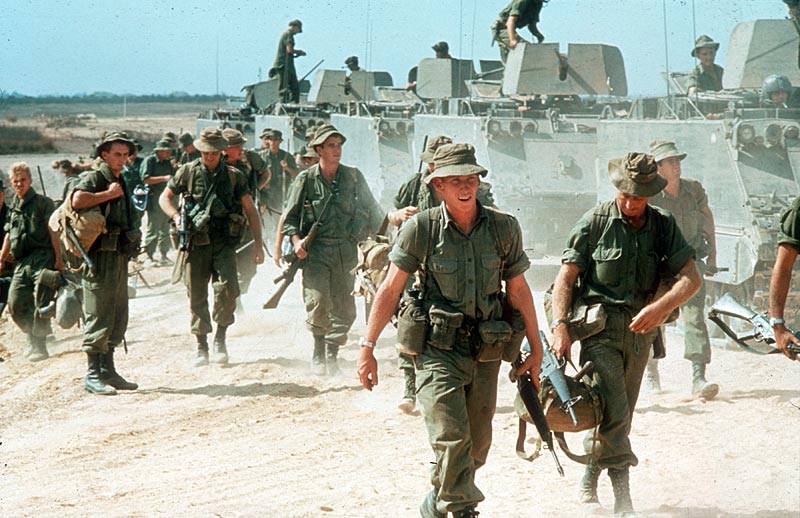The Battle of Suoi Bong Trang, which took place on February 23-24, 1966, was a confrontation between US, Australian, and New Zealand forces, and the Viet Cong and North Vietnamese Army during the Vietnam War. This engagement occurred within the scope of Operation Rolling Stone, an American security operation aimed at safeguarding engineers constructing a strategically significant road near Tan Binh in central Binh Duong Province, approximately 30 kilometres northwest of Bien Hoa airbase.
The conflict involved troops from the US 1st Brigade, 1st Infantry Division, and the 1st Battalion, Royal Australian Regiment (1 RAR), which was attached for the operation. These forces successfully defended against a regimental-sized Viet Cong night assault. The Viet Cong, repelled by concentrated firepower from artillery and tanks, suffered substantial casualties and withdrew by morning. Following the attack, there was no pursuit of the Viet Cong by the American and Australian forces, as their focus shifted to securing the battlefield and evacuating their own casualties. Despite occasional sniper and mortar fire from the Viet Cong in the aftermath, these tactics proved ineffective, and the road construction was completed by March 2.
In February 1966, as part of an American road-building initiative challenging the Viet Cong’s mobility around Saigon, the US 1st Engineer Battalion, led by Lieutenant Colonel Howard Sargent, was constructing an all-weather road in central Binh Duong Province. This road aimed to disrupt communist supply routes and connect various zones while extending the South Vietnamese government’s authority. In response to Viet Cong harassment against the engineers, Operation Rolling Stone was launched by elements of the US 1st Division, with the US 1st Brigade tasked to guard engineers on a rotating basis and conduct probing operations against Viet Cong positions.
Simultaneously, 1 RAR, led by Lieutenant Colonel Alex Preece, detached from the US 173rd Airborne Brigade, was placed under the operational command of the US 1st Division until March 5. This decision was based on the Australians’ reputation for dispersed, aggressive patrolling. The Australian forces, supported by vehicles, helicopters, and artillery, were assigned the mission to protect the engineer base and road work parties.
By February 19, 1 RAR took over from the US 38th Infantry Regiment and implemented a dispersed patrolling strategy, reducing Viet Cong activity. Suspecting a major attack, the Australians, by February 22, engaged Viet Cong Main Force elements, escalating tensions. The night of February 23-24 saw a significant Viet Cong assault, involving three battalions from the 9th Division.
The battle ensued with 1 RAR adopting an all-round defensive position. US reinforcements, including tanks and artillery, were brought in to defend the Brigade Headquarters. The Viet Cong initiated a night assault with mortar and small arms fire, met by intense American and Australian firepower. Although the Australian position faced mortar attacks, the Viet Cong’s attempt was futile, and they suffered heavy losses.
Casualties included 89 dead and 11 wounded Viet Cong, primarily inflicted by American forces. The US-Australian combined force experienced limited casualties, with 11 Americans and two Australians killed, and 72 Americans and two Australians wounded. The battlefield aftermath revealed significant Viet Cong casualties, equipment capture, and destruction of American tanks and personnel carriers.
In summary, the Battle of Suoi Bong Trang was a decisive victory for the US-Australian forces and stands as a testament to the effectiveness of the US-Australian forces in repelling a determined Viet Cong assault. Their coordinated efforts not only secured the battlefield but also ensured the completion of the strategically significant road by March 2, thereby achieving the objectives set forth by Operation Rolling Stone.










